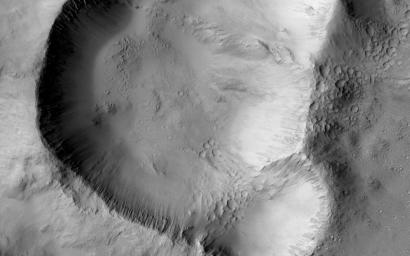
|
Triple-Crater in Elysium Planitia
- Click the image above for a larger view
- Full-Res JPEG (2880 x 1800) (542.9 kB)
- Full-Res TIFF (2880 x 1800) (5.2 MB)
Caption:

Map Projected Browse Image
Click on the image for larger version
This image shows a triple impact crater in Elysium Planitia near Tartarus Montes, which probably formed when a binary-or even triple-asteroid struck the surface. (Binary asteroids orbit each other, while also orbiting the Sun). The two larger craters must have been produced by asteroids of approximately the same size, on the order of a few hundred meters across.
The northern crater might have been created by a smaller asteroid, which was orbiting the larger binary pair, or when one of the binary asteroids broke up upon entering the atmosphere. The shape of the triple-crater is oblong, suggesting an oblique impact; therefore, another alternative would be that the asteroid split upon impact and ricocheted across the surface, creating additional craters.
What evidence is visible in this image that shows that the three craters did not form independently? The ejecta blanket appears to be uniform around the triple-crater showing no signs of burial or overlapping ejecta from overprinting craters. The crater rims are significantly stunted where the craters overlap .
The image is an excerpt from HiRISE observation ESP_039308_1915, taken Dec. 15, 2014. Other image products from this observation are available at ESP_039308_1915 .
Background Info:
The University of Arizona, Tucson, operates HiRISE, which was built by Ball Aerospace & Technologies Corp., Boulder, Colo. NASA's Jet Propulsion Laboratory, a division of the California Institute of Technology in Pasadena, manages the Mars Reconnaissance Orbiter Project for NASA's Science Mission Directorate, Washington.
Cataloging Keywords:
| Name | Value | Additional Values |
|---|---|---|
| Target | Mars | |
| System | ||
| Target Type | Planet | Asteroid |
| Mission | Mars Reconnaissance Orbiter (MRO) | |
| Instrument Host | Mars Reconnaissance Orbiter | |
| Host Type | Orbiter | |
| Instrument | High Resolution Imaging Science Experiment (HiRISE) | |
| Detector | ||
| Extra Keywords | Atmosphere, Binary, Crater, Grayscale, Impact, Map, Mountain | |
| Acquisition Date | ||
| Release Date | 2015-01-22 | |
| Date in Caption | 2014-12-15 | |
| Image Credit | NASA/JPL-Caltech/University of Arizona | |
| Source | photojournal.jpl.nasa.gov/catalog/PIA19138 | |
| Identifier | PIA19138 | |
